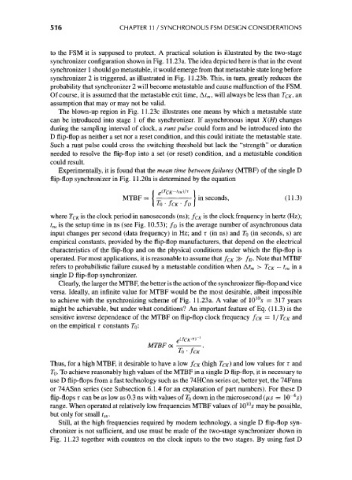Page 546 - Engineering Digital Design
P. 546
516 CHAPTER 11 /SYNCHRONOUS FSM DESIGN CONSIDERATIONS
to the FSM it is supposed to protect. A practical solution is illustrated by the two-stage
synchronizer configuration shown in Fig. 11.23a. The idea depicted here is that in the event
synchronizer 1 should go metastable, it would emerge from that metastable state long before
synchronizer 2 is triggered, as illustrated in Fig. 11.23b. This, in turn, greatly reduces the
probability that synchronizer 2 will become metastable and cause malfunction of the FSM.
Of course, it is assumed that the metastable exit time, At m, will always be less than T CK, an
assumption that may or may not be valid.
The blown-up region in Fig. 11.23c illustrates one means by which a metastable state
can be introduced into stage 1 of the synchronizer. If asynchronous input X(H) changes
during the sampling interval of clock, a runt pulse could form and be introduced into the
D flip-flop as neither a set nor a reset condition, and this could initiate the metastable state.
Such a runt pulse could cross the switching threshold but lack the "strength" or duration
needed to resolve the flip-flop into a set (or reset) condition, and a metastable condition
could result.
Experimentally, it is found that the mean time between failures (MTBF) of the single D
flip-flop synchronizer in Fig. 11.20a is determined by the equation
MTBF = { [ in seconds, (11.3)
[ TO • JCK • JD \
where TCK is the clock period in nanoseconds (ns); f CK is the clock frequency in hertz (Hz);
t su is the setup time in ns (see Fig. 10.53); f D is the average number of asynchronous data
input changes per second (data frequency) in Hz; and r (in ns) and TO (in seconds, s) are
empirical constants, provided by the flip-flop manufacturers, that depend on the electrical
characteristics of the flip-flop and on the physical conditions under which the flip-flop is
operated. For most applications, it is reasonable to assume that f CK ^> f D. Note that MTBF
refers to probabilistic failure caused by a metastable condition when At m > TCK — t su in a
single D flip-flop synchronizer.
Clearly, the larger the MTBF, the better is the action of the synchronizer flip-flop and vice
versa. Ideally, an infinite value for MTBF would be the most desirable, albeit impossible
10
to achieve with the synchronizing scheme of Fig. 11.23a. A value of 10 s = 317 years
might be achievable, but under what conditions? An important feature of Eq. (11.3) is the
sensitive inverse dependence of the MTBF on flip-flop clock frequency /CK = I/ TCK and
on the empirical r constants 7b:
MTBFoc
TO • fcK
Thus, for a high MTBF, it desirable to have a low /CK (high TCK) and low values for r and
TQ. To achieve reasonably high values of the MTBF in a single D flip-flop, it is necessary to
use D flip-flops from a fast technology such as the 74HCnn series or, better yet, the 74Fnnn
or 74ASnn series (see Subsection 6.1.4 for an explanation of part numbers). For these D
6
flip-flops T can be as low as 0.3 ns with values of T 0 down in the microsecond (/JLS = 10~ s)
range. When operated at relatively low frequencies MTBF values of 10'°s may be possible,
but only for small t m.
Still, at the high frequencies required by modern technology, a single D flip-flop syn-
chronizer is not sufficient, and use must be made of the two-stage synchronizer shown in
Fig. 11.23 together with counters on the clock inputs to the two stages. By using fast D

